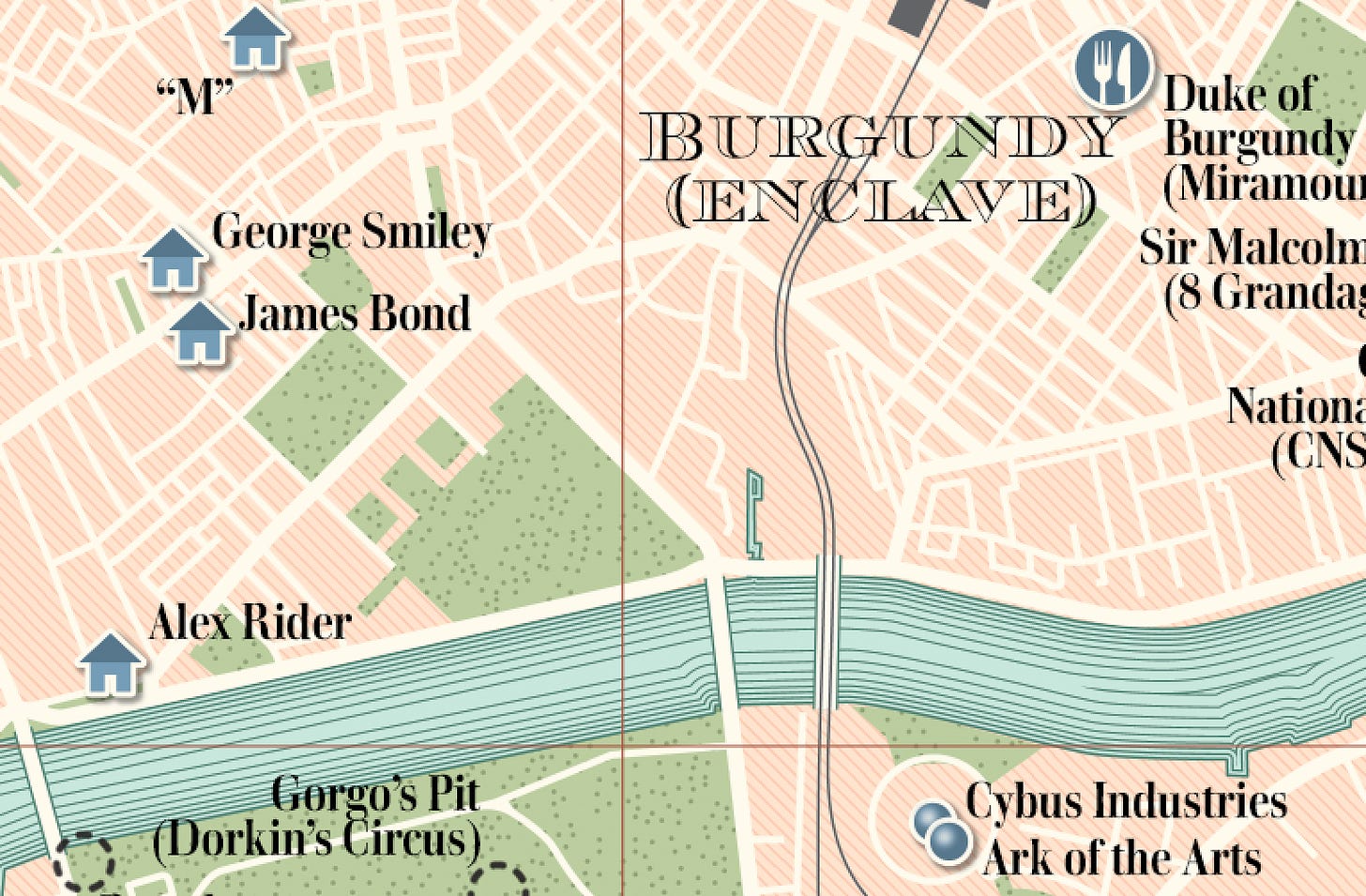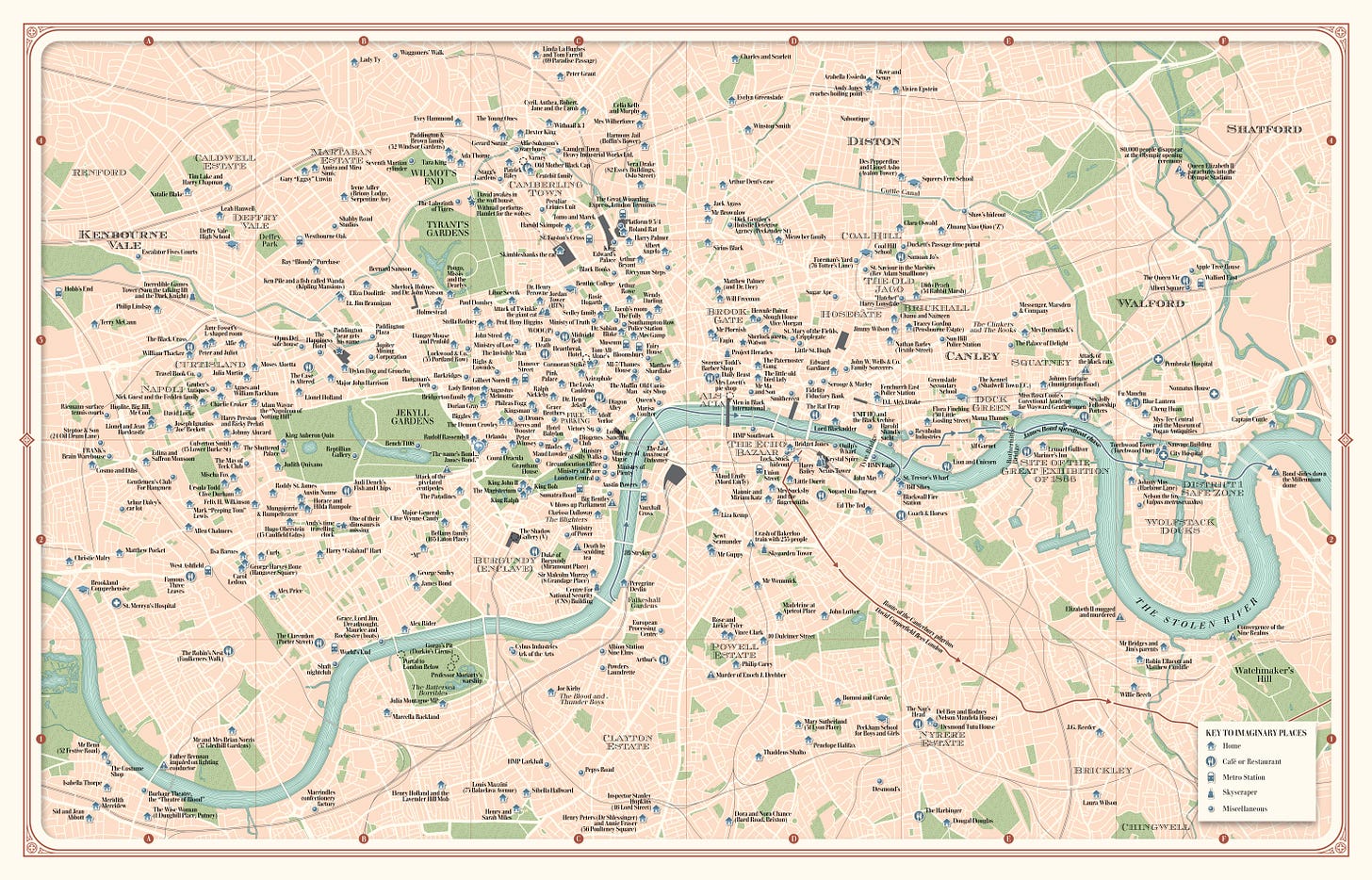Who Lives Where In Fictional London?
I have a new book out, which weaves together London fiction from different eras.
I have a new book out. And, of course, it’s full of maps. Atlas of Imagined Cities takes 14 world cities (including London) and plots where famous fictional characters lived, worked, played, loved and fought. In today’s newsletter, I’d like to take you on a tour of fictional London, featuring characters from the past, present and future. Proper time machine stuff.
That’s for the main feature. First this:
History Radar
Upcoming events of interest to London history fans.
📽️ CINEMA MUSEUM: Final call for anyone who wants to join our Londonist: Time Machine’s visit to the Cinema Museum in Kennington tomorrow (Saturday). The talk and tour starts at 2pm and costs £10 per person (£7 concessions). Please email me on matt@londonist.com if you’d like to join us.
🇺🇸 INDEPENDENCE DAY: On 4 July, Love London Tours guides Phil and Caroline offer an Independence Day walk around Mayfair, paying special attention to historical links between London and the USA. Topics covered include the short-lived Republic of Texas, Wallis Simpson, and Churchill and Roosevelt's joint efforts to defeat Nazi Germany.
🚇 ACTON DEPOT: Next weekend (5-7 July) offers a rare chance to explore an Aladdin’s cave of transport history. London Transport Museum opens the doors of its Depot in Acton, inviting you to discover over 320,000 historical objects, alongside a lively programme of events. Honestly, it’s one of the best days out in London.
⚓️ VICTORIAN PORT: On 5 July, Tom Furber of the London Metropolitan Archives gives a history talk about the Victorian port of London, using documents from the collection to give an insight into what was once the busiest port in the world. The event ties in to the current Lost Victorian City exhibition.
🖼️ TURNER AND THE ENVIRONMENT: There's a new exhibition at Turner's House in Twickenham, the former home of artist J.M.W. Turner. A World of Care: Turner and the Environment looks at how his work portrayed environmental and social developments -- including burning furnaces and deforested landscapes -- that would go on to change Britain and the world‘s climates forever.
👗 FASHION CITY: Last chance to see the excellent Fashion City exhibition at Museum of London Docklands, which ends on 7 July. It looks at the contribution of Jewish designers and tailors in making London a fashion powerhouse. Objects featured include a famous red coat worn by Princess Diana, and the unique garb of Dot Cotton from Eastenders.
Who Lives Where In Fictional London?
Did you know that James Bond shares a milkman with George Smiley? Literature’s two most famous spies live close enough to flash secret codes at one another. Bond’s address is never given explicitly, but clues from several films and books point to Wellington Square in Chelsea. Meanwhile, John Le Carré gives Smiley’s address as 9 Bywater Street — the road directly opposite Wellington Square. Bond’s boss “M” is but a few blocks away, and boy spy Alex Ryder also lives round the corner. I imagine they have a very effective Neighbourhood Watch in fictional Chelsea.
I had no idea that London contained such a tight hub of fictional espionage until I started working on the Atlas of Imagined Cities, with my co-author Rhys B. Davies and illustrator Mike Hall.
The book, out now from Batsford, plots thousands of locations from novels, TV shows, movies, video games and other fictional media. In the spirit of Londonist: Time Machine, the maps leap around the decades and centuries. You’ll find Edwardian flying nannies sharing the pages with alien invaders and Tudor lawyers (hello Shardlake). The book covers 14 world cities, but today I’ll focus on some of the London highlights.
First, here’s a zoomable version of our map of central London for you to play with:
This map alone contains several hundred fictional people and places, from Walford (Eastenders) in the east to Hobbs End (Quatermass) in the west. Sometimes it was easy to plot a fictional character. Count Dracula’s house, for example, is well described by Bram Stoker as standing on Piccadilly. Other locations take a bit of sleuthing. Walford is obviously in the East End, but where? The biggest clue comes from episodes that show the fictional Walford East tube station. The background tube map places it on the District line where you would normally find Bromley-by-Bow… so that’s where we’ve placed Albert Square.
Where the Dickens?
The project started several years ago now, when I decided to read all the Charles Dickens novels and map every location mentioned therein. Regular readers will have seen the fruits of that pleasurable labour, which was published here on Londonist: Time Machine as the Ultimate Map of Charles Dickens’s London. I did a similar exercise for Sherlock Holmes, as well as the novels of Virginia Woolf. Yes, I know.
While working my way through these collections, it occurred to me that the idea could be expanded to other works of fiction. Indeed, to all works of fiction. What would happen, I wondered, if characters from TV, movies, novels and video games, from all time periods, were placed onto the same map. Who would live nextdoor to whom? And that’s where Atlas of Imagined Cities came from.






